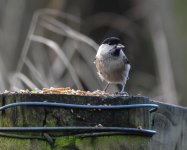brassmammoth
Member

Hi there!
I was wondering if anyone could lend some expertise in identifying this bird. I'm thinking marsh or willow tit - but I have heard separating the two can be difficult.
Spotted in a boggy old woodland - Askham Bog, York to be specific. Only got the one photo and I didn't catch the call unfortunately - I have read this is the easiest way to ID.
Any help would be appreciated!
Lee
I was wondering if anyone could lend some expertise in identifying this bird. I'm thinking marsh or willow tit - but I have heard separating the two can be difficult.
Spotted in a boggy old woodland - Askham Bog, York to be specific. Only got the one photo and I didn't catch the call unfortunately - I have read this is the easiest way to ID.
Any help would be appreciated!
Lee







